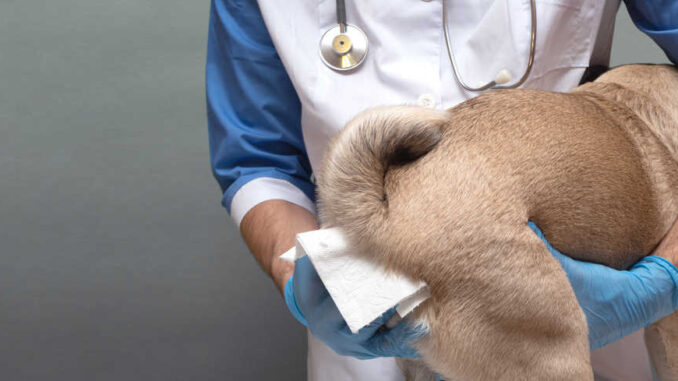
This article was updated on October 2nd, 2023
One of my pet parents brought his dog to the clinic because she had swelling around her anus. When I entered the exam room, I immediately noticed a fishy odor. Based on the dog’s history and my exam findings, I confirmed my suspicions that my patient has swollen anal glands.
In this article, I’ll explain how you can tell your dog’s anal glands are swollen and what can cause it. Then, I’ll let go over the symptoms to look for and how to diagnose swollen anal glands. To help you help your pooch, I’ll share what you can do about swollen anal glands and when you need to call your vet.
Overview of swollen anal glands in dogs
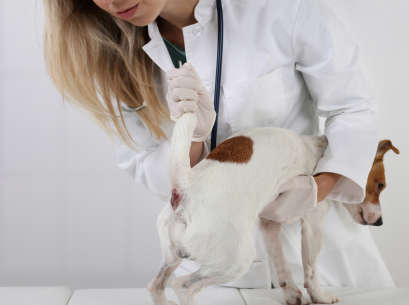
All members of the canine species have modified sweat glands called anal glands. These glands produce a pungent fluid that helps dogs mark their territory and communicate with other pups. The liquid collects in sacs located on either side of your dog’s anus.
Under normal conditions, your furbaby naturally expresses or empties his anal sacs when he poops as firm feces press against the sacs from inside the rectum. However, if the glands don’t empty properly, the liquid collects and thickens in the anal sacs. The ducts clog with the thick fluid, creating conditions that can cause swollen anal glands. An estimated 5-12% of dogs will experience anal sac problems at some time in their lives.
What do swollen anal glands look like? Can you tell from the outside?
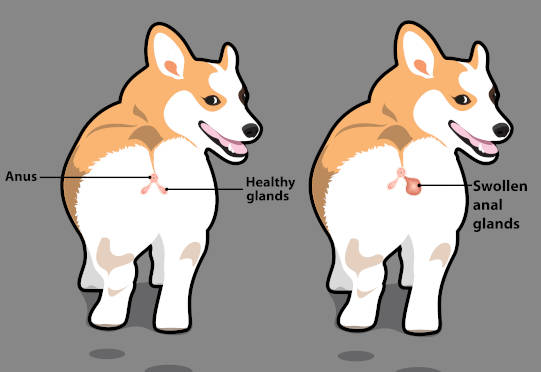
Anal glands are located in your dog’s rectum between the inner and outer muscle layers. The sacs sit just below the anus at about the 4-5 and 7-8 o’clock positions. When they start to swell, you may not notice bulges from the outside, but your pup will show signs of discomfort including continual licking/biting his rear end, suddenly turning to look at his butt, and straining to defecate.
If your dog’s anal glands are impacted and the swelling increases, you may notice general swelling and redness around his anus. It’s less likely to see individual bulges.
What are the causes of swollen anal glands in dogs?
Several factors can cause improper emptying of the anal glands. When they can’t empty, the sacs fill with fluid, the liquid thickens, and the ducts clog. Blocked anal glands continue to collect fluid and become swollen.
1. Infections
Like humans, dogs normally have certain yeast and bacteria on their skin. If something causes the microorganisms to overgrow, they can colonate the area and cause chronic infections. As a result, the area becomes inflamed which can affect the anal gland ducts. If swelling occludes the ducts, they will clog and cause the sacs to fill and swell.
Common signs of skin infections include:
- Inflamed, reddened skin
- Constant licking, scratching, or biting
- Crusty, flaky skin
- Small pustules(bacteria)
- Greasy hair coat(yeast)
- Foul, yeasty odor(yeast)
While you can use home remedies like an oatmeal bath or baking soda to help ease your dog’s itching, it will not cure the infection. When you suspect bacterial or yeast dermatitis, contact your veterinarian. The doctor will be able to confirm a diagnosis and treat your furbaby with oral antibiotics or antifungals. He may also prescribe medicated shampoo. Learn more about infected anal glands in dogs.
2. Allergies
Dogs can have allergic reactions to certain chemicals, foods, and environmental stimuli. Depending on how the allergens affect your dog, he may experience skin symptoms, including:
- Hair loss
- Itchy skin
- Excessively licking, scratching, or biting affected areas
- Chronic ear infections
- Red, inflamed skin
- Poor hair coat
- Hives
Additionally, skin chronic allergic dermatitis can cause swelling of the anal gland ducts resulting in impaction and swollen sacs. Dogs with food sensitivities or allergies may also have gastrointestinal symptoms like soft stools or diarrhea. If the feces are chronically soft, your furbaby won’t be able to naturally express his anal glands.
The best thing you can do to help your furbaby is to avoid triggers. Unfortunately, diagnosing specific allergens can be tricky in dogs. If needed, your veterinarian may treat the symptoms with antihistamines or other allergy relief medications.
3. Obesity
Dogs that are obese weigh 20% or more than their ideal weight. When your pup gains extra pounds, they deposit fat in various body locations, including around the rectum and anus. If your dog is obese, there may be excess fat padding between the rectum and anal sacs That means normal feces may not exert enough pressure to naturally express the anal glands during defecation. Obesity can also cause narrowing of the anal gland ducts. Either way, the glands won’t empty properly, so they fill up and swell.
If your dog has put on weight, he may demonstrate lethargy or exercise intolerance. You may also notice his collar is tighter than before and that you can’t see a waistline or feel his ribs under the skin. Overweight dogs need to be placed on a restricted calorie diet to help them reach their ideal weight.
4. Skin parasites
Fleas and mites can cause anal gland impaction/blockage. If your dog develops an allergy to flea saliva, he will have inflamed, itchy skin when the tiny parasites bite him. When the inflammation is around the rear end, it leads to clogged anal sac ducts and swollen glands. Similarly, skin mites can cause skin irritation that affects the ducts. These critters also burrow under the skin and may damage the anal gland passageway causing impaction.
Symptoms of external parasites may include:
- Itchy skin
- Presence of fleas or mites
- Licking or biting the rear end continually
- Hair loss around the tail and hind legs
- Crusty, swollen, or red skin
- Secondary infections
If you notice symptoms of external parasites, contact your veterinarian. He can examine your pooch and confirm a diagnosis. Once you treat your pup with an appropriate antiparasitic drug, dip, or topical application, you will also need to clean up the environment to eliminate parasites and their larvae. Usually, treating to eliminate the pests will clear up the problem. However, if the skin irritation is severe, your veterinarian may also prescribe anti-inflammatory medications.
5. Dietary
The key to natural anal gland expression is regular, firm stools. If your dog’s diet lacks sufficient dietary fiber, the feces may be too soft to apply adequate pressure on the anal sacs. If your dog’s diet isn’t providing enough bulk, you may notice chronically soft or squishy stools.
To help dogs with repeatedly squishy poop, you can increase their fiber intake. Talk to your veterinarian about transitioning to food that’s high in fiber to add bulk to your furbaby’s feces. You can also give your dog a fiber supplement such as psyllium or feed high-fiber treats. Read our article about pumkin and anal gland issues to learn more.
6. Congenital
Some dogs are more predisposed to blocked and swollen anal glands because they’re born with congenitally narrow ducts. As a result, it takes more pressure to express liquid from the anal sacs, and they may not empty completely during defecation.
While any dog can be born with narrow ducts, it’s more common in toy and miniature-breed dogs such as toy/miniature poodles, Lhasa apsos, and Chihuahuas. If you choose a smaller-breed dog, work with a reputable breeder and ask if there are any past anal gland issues with the family line.
7. Tumors
Swellings or growths in the rectum or anal gland can cause the sacs to swell. The apocrine sweat glands that line the anal sacs can develop adenocarcinomas. These tumors are more common in older dogs, and they’re usually unilateral(in one sac). Signs of anal sac adenocarcinoma include:
- Straining to defecate or constipation
- Lethargy
- Loss of appetite
- Vomiting
- Increased thirst/urination
- Bulge or swelling around the anus
- Weakness or swelling of the hind legs
An adenocarcinoma around the anus will impinge on the anal gland ducts and prevent emptying. Larger tumors may also interfere with your dog’s defecation. To prevent constipation, your veterinarian may prescribe stool softeners. However, the tumor will need to be surgically removed. The prognosis is good with early detection and treatment. Life expectancy after surgery averages 1-2 years.
What are the symptoms of swollen anal glands in dogs?
Swollen anal glands in dogs are uncomfortable and sometimes painful. As a result, they may exhibit:
- Scooting the butt across the floor or lawn
- Constantly licking or biting at the anus
- Resistance to sitting
- Straining to poop
- Crying or showing pain when pooping
- General swelling or bulges at the base of the anus
- A strong fishy odor
- Brown spotting on furniture or bedding where your dog sleeps
What should I do when I notice swollen anal glands in my dog?
You’re most likely to notice your dog scooting before you catch other symptoms of swollen glands. When you see the behavior,
- Contact your veterinarian and schedule an appointment. Early diagnosis and treatment of underlying causes can speed your dog’s recovery and may prevent other health problems.
- While you’re waiting for the appointment, apply a warm compress of water or salt water to your dog’s anus to help open the ducts and relieve some pressure.
- If your dog won’t leave his hind end alone, use an e-collar to prevent continued licking and chewing.
Are there products I can try safely at home to see if they help?
Usually, swollen anal glands are impacted and require manual expression or emptying to fix the problem. However, you may be able to try some products at home to help prevent a recurrence.
Supplements
Certain supplements support digestive health and reduce inflammation which in turn promotes natural anal gland expression and helps to prevent clogged ducts.
- Omega 3 Fatty Acids – salmon oil or other omega 3 fatty acid supplements for dogs help to reduce inflammation.
- Glandex – Glandex is a veterinary-formulated supplement that contains ingredients including fiber and digestive enzymes to support healthy anal gland function.
- Probiotics and Prebiotics – Probiotics and prebiotic fiber support healthy digestion and firm, regular bowel movements.
Fiber
Fiber adds bulk to the diet and can help to firm up soft stools. You can feed your dog a commercial brand that’s high in fiber to encourage natural anal gland expression. Ask your veterinarian to recommend a product that suits your furbaby’s needs.
Another way to boost your dog’s fiber is by giving him fiber-rich foods as a treat or supplement to his daily meal. Try:
- Pumpkin – You can add about 1 tablespoon per 10 pounds of body weight. Use plain, canned pumpkin with no added spices or fresh, steamed pumpkin.
- Banana – Feed some banana slices as special treats or mash some up and stuff them in a Kong toy. However, feed bananas in moderation because they’re higher in sugar.
- Sweet potato – Boil and mashed sweet potatoes and add the same dose as pumpkin to your dog’s food. It will add fiber and omega fatty acids to the diet, which can help to reduce inflammation.
- Apples – Core and seed-free apple slices make a nutritious, crunchy, fiber-filled snack for your dog.
- Carrots – Speaking of crunchy, most dogs love carrots. Feed small pieces of baby carrot as a snack or grind some carrots up to mix into your pal’s dinner.
- Brown rice – You can add up to ¼ cup of cooked or steamed brown rice to your dog’s food to increase his fiber intake.
- Beets/beet pulp – Plain raw, steamed, or boiled beets add prebiotic fiber to your pup’s food. Don’t use pickled or canned beets because they have added salt, which can be dangerous for your dog’s health.
Water
Water promotes healthy digestion and helps to keep your pal regular. If your dog isn’t getting enough water, encourage him to ingest more fluid by adding some sodium-free beef or chicken broth to the water or feeding canned food.
Exercise
Regular exercise stimulates smooth muscle contractions in the digestive tract for regular bowel movements. It also helps to build abdominal and rectal muscle tone allowing your dog to exert greater pressure on the anal sacs during defecation. Both of these effects help your dog to express his anal glands naturally.
When should I seek veterinary assistance?
Any time you notice signs of swollen or blocked anal glands, you should contact your veterinarian. While warm compresses and exercise may help open the ducts, once the sacs swell and the fluid thickens, the condition usually progresses without treatment.
Sometimes, swollen anal glands point to a more serious condition than impaction, so we don’t recommend attempting to diagnose your pooch and manually express the glands yourself Contact your veterinarian to schedule an appointment if:
- Your dog has a strong, fishy odor that won’t resolve with a bath
- There’s redness and swelling under your dog’s tail, and the area is painful to the touch
- Your dog has a brownish-red discharge around his anus or on his bedding
- You see abscesses or pus drainage around the anus
How will my vet diagnose swollen anal glands?
Diagnosing swollen anal glands is usually straightforward based on your dog’s history and a physical examination. Most veterinarians are all too familiar with swollen anal glands and know what to look for.
During the exam, your veterinarian will check your pup’s anus and perform a digital rectal examination. He may express fluid from the sacs and evaluate the color and consistency. If the rectal palpation suggests a tumor, the doctor will perform additional diagnostic tests like an ultrasound, fine needle aspirate, or tissue samples.
What are the treatment options and likely costs?
Dogs with swollen anal glands will likely require treatment to resolve the condition. If you ignore them, the sacs will continue to fill with liquid and may abscess or rupture. Depending on the reason for swelling of your dog’s anal glands and any risk factors he may have, treatment may involve:
- Manual expression of the anal glands – cost is usually around $50
- Flushing of infected anal glands with antibiotics – cost is about $100+ depending on whether your dog requires sedation
- Surgical removal of tumors or chronically/severely impacted glands generally requires a veterinary surgical specialist and can run $750-2500.
Frequently asked questions
Are certain breeds more prone to anal gland issues?
According to a 2021 cross-sectional study of anal sac disease in dogs and cats, certain dog breeds are more predisposed to developing anal gland problems. Generally, smaller breeds have a higher risk of issues. Some top at-risk breeds include:
- Dachshund
- Chihuahua
- Lhasa Apso
- Jack Russel Terrier
- Beagle
- French Bulldog
- Labrador Retriever
- German Shepherd
Is it painful for my dog to have his anal glands expressed?
Usually, anal gland expression won’t be painful for your dog as long as it’s performed properly by a trained professional. Your veterinarian is the best person to complete the procedure. Emptying the glands should help to relieve the pressure and ease your dog’s discomfort. Of course, if the anal sacs are already inflamed and painful, your dog may require sedation.
What should I do if my dog’s anal glands become infected?
If your dog’s anal glands become infected, contact your veterinarian. Without treatment, the bacteria won’t stop growing, and the sacs can become abscessed or rupture. Your dog will require antibiotics, and your veterinarian may also prescribe anti-inflammatory and pain medications.
How often should I have my dog’s anal glands checked?
Most dogs won’t experience problems with their anal glands, so they can be checked as part of an annual physical or when you notice signs of a problem. If your furbaby has anal gland issues, then it’s wise to have your veterinarian check them more frequently. For some dogs, a few times a year is sufficient, but others may need to be checked monthly. Consult with your veterinarian to determine the best frequency for your furbaby.
Can swollen anal glands in dogs lead to more serious problems?
When dogs’ anal glands are swollen, the condition won’t resolve without treatment. Taking a wait-and-see approach can lead to more serious problems because the sacs will continue filling up. The fluid becomes stagnant and provides a growth medium for bacteria causing infections and abscesses. Glands that become too full can also rupture from the pressure.
Related posts:
Disclaimer: This website's content is not a substitute for veterinary care. Always consult with your veterinarian for healthcare decisions. Read More.


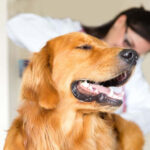
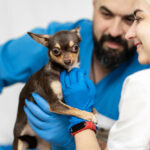
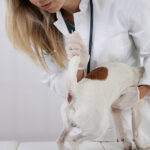
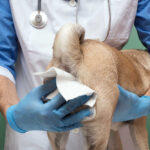
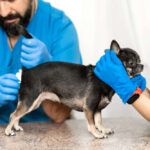
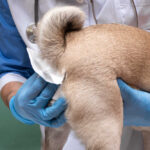
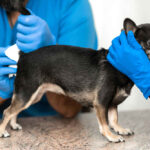

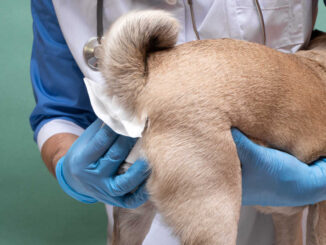
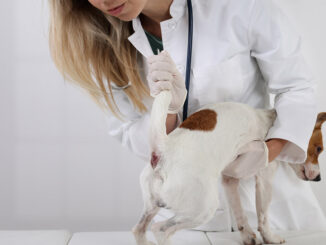
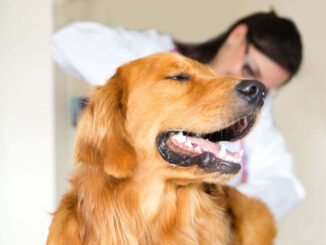
Be the first to comment